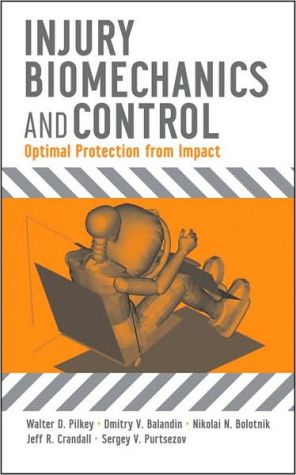

 |

|

Sold Out
Book Categories |
PREFACE.
Chapter 1 INTRODUCTION.
1.1 Motivation for Writing this Book.
1.2 The Structure of the Book.
1.3 Related Studies.
REFERENCES.
Chapter 2 FUNDAMENTALS OF IMPACT AND SHOCK ISOLATION.
2.1 Shock Loading: Basic Models and Characteristics.
2.1.1 External disturbance. Kinematic and dynamic disturbances.
2.1.2 Shock disturbance.
2.1.3 Instantaneous shock.
2.2 Shock Isolation.
2.2.1 Shock isolation of an object on a moving base.
2.2.2 Shock isolation of a fixed base.
2.3 The Isolator as a Control Medium. Active and Passive Isolators.
2.4 Does Isolation of an Object from the Base Always Lead to a Reduction in the Shock Load Transmitted to the Object?.
REFERENCES.
Chapter 3 BASIC OPTIMAL SHOCK ISOLATION: SINGLE DEGREE OF FREEDOM SYSTEMS.
3.1 Basic Problems.
3.1.1 Mechanical model. Equation of motion.
3.1.2 Performance criteria.
3.1.3 Statements of the optimal shock isolation problems.
3.1.4 Reciprocity (duality) of optimization problems.
3.2 Limiting Performance Analysis: Basic Concept and Analytical Results.
3.2.1 Basic concept.
3.2.2 Shock pulses with one excursion beyond the upper bound allowed for the control force. Constant force deceleration.
3.2.3 Limiting performance curve.
3.3 Limiting Performance Analysis: Computational Approach.
3.3.1 Discretization of the Equation of Motion and the Performance Criteria.
3.3.2 Numerical solution of Problem 3.1.
3.3.3 Numerical Solution of Problem 3.2.
3.4 Parametric Optimization.
3.4.1 Basic concepts. Problem definitions.
3.4.2 Parametric optimization of power-law isolators for an instantaneous shock pulse.
3.5 Pre-acting Control for Shock Isolators.
3.5.1 Basic concept. Statements of the problems.
3.5.2 Limiting performance analysis. Instantaneous shock.
3.5.3 Parametric optimization of a pre-acting shock isolator.
3.6 Best and Worst Disturbance Analyses.
3.6.1 Basic concept. Statement of the optimal control problems.
3.6.2 Best and worst disturbance analyses for a system with a linear spring-and-dashpot isolator.
3.6.3 Rational design of sled test standards.
REFERENCES.
Chapter 4.
OPTIMAL SHOCK ISOLATION FOR MULTI DEGREE OF FREEDOM SYSTEMS.
4.1 Optimal Shock Isolation for a Two-Component.
Viscoelastic Object.
4.1.1 Statement of the problem.
4.1.2 Rigid body model.
4.1.3 Construction of the optimal control for the two-body model based on the optimal control for the rigid model.
4.1.4 Near-optimal control for the two-body model based on the optimal control for the rigid model.
4.1.5 Constant-force control versus the optimal control.
4.2 Optimal Shock Isolation for Three-Component Structures.
4.2.1 Introduction.
4.2.2 Shock isolation of a rigid object.
4.2.3 Shock isolation of a multi-body object.
REFERENCES.
Chapter 5 SPINAL INJURY CONTROL.
5.1 Description of the Model.
5.2 Minimization of the Occupant’s Displacement subject to a Constraint Imposed on the Spinal.
Compressive Force.
5.2.1 Statement of the problem.
5.2.2 Solution.
5.2.3 Trade-off curve. Reciprocal problem.
5.2.4 Maximum spinal compressive force in the absence of a shock isolator.
5.3 Spinal Injury Control System with two Shock Isolators.
5.4 MADYMO Simulation for the Limiting Performance Analysis.
5.4.1 Model configuration and statement of the problem.
5.4.2 Solution procedure.
5.4.3 Conclusions.
REFERENCES.
Chapter 6 THORACIC INJURY CONTROL.
6.1 Smart Restraint Systems.
6.2 Basic Concept of Restraint Force Control.
6.2.1 Model description.
6.2.2 Limiting performance.
6.2.3 Passive linear elastic isolator.
6.2.4 Linear elastic isolator with controlled tension.
6.2.5 Sensitivity analysis of the open-loop control of the attachment.
6.2.6 Feedback control for the attachment point motion.
6.3 Limiting Performance Analysis for the Prevention of Thoracic Injuries in a Frontal Car Crash.
6.3.1 Thoracic injury model and criteria.
6.3.2 Statement of the problem.
6.3.3 Solution plan. An auxiliary problem.
6.3.4 Numerical results.
6.4 Feedback Control of the Elastic Restraint Force on the Basis of the Two-mass Thorax Injury Model.
6.4.1 Determination of the optimal motion of the restraint attachment point.
6.4.2 Sensitivity analysis.
6.4.3 Feedback control of the restraint force.
6.4.4 Constant force control.
6.5 Conclusions.
REFERENCES.
Chapter 7 HEAD INJURY CONTROL.
7.1 Head Injury Criterion: Historical Perspectives.
7.2 Minimization of the Deceleration Distance for Constrained HIC.
7.2.1 Statement of the optimal control problem.
7.2.2 Construction of the solution.
7.2.3 Analysis and discussion of the results.
7.3 Minimization of the HIC for Constrained Deceleration Distance.
7.4 Alternative Control Laws.
7.4.1 Constant force deceleration.
7.4.2 Power-law deceleration.
7.4.3 Comparison of the optimal and alternative control laws.
REFERENCES.
Chapter 8 INJURY CONTROL FOR WHEELCHAIR OCCUPANTS.
8.1 Introduction.
8.2 Optimal Shock Isolation of Single-Degree-of-Freedom System.
8.2.1 Mathematical model.
8.2.2 Optimal control.
8.3 Simulation Using MADYMO.
8.3.1 Model structure and parameters.
8.3.2 Goals of simulation.
8.3.3 Response criteria.
8.3.4 Simulation technique.
8.3.5 Input data.
8.3.6 Results.
8.4 Discussion.
REFERENCES.
INDEX.
Login|Complaints|Blog|Games|Digital Media|Souls|Obituary|Contact Us|FAQ
CAN'T FIND WHAT YOU'RE LOOKING FOR? CLICK HERE!!! X
 You must be logged in to add to WishlistX
 This item is in your Wish ListX
 This item is in your CollectionInjury Biomechanics and Control: Optimal Protection from Impact
X
 This Item is in Your InventoryInjury Biomechanics and Control: Optimal Protection from Impact
X
 You must be logged in to review the productsX
 X
 X

Add Injury Biomechanics and Control: Optimal Protection from Impact, With this book as their guide, readers will discover how to design better protective equipment and devices such as helmets, seat belts, and wheelchairs in order to minimize the risk or the extent of injury to people subjected to impact loads. It is based , Injury Biomechanics and Control: Optimal Protection from Impact to the inventory that you are selling on WonderClubX
 X

Add Injury Biomechanics and Control: Optimal Protection from Impact, With this book as their guide, readers will discover how to design better protective equipment and devices such as helmets, seat belts, and wheelchairs in order to minimize the risk or the extent of injury to people subjected to impact loads. It is based , Injury Biomechanics and Control: Optimal Protection from Impact to your collection on WonderClub |